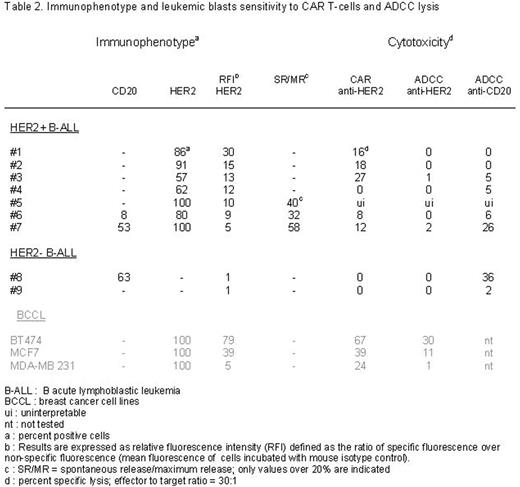Abstract
Introduction: Prognosis of acute lymphoblastic leukemia (ALL) in adults remains dismal. Recent advances have consisted of targeted therapies with monoclonal antibodies and chimeric antigen receptor (CAR) T lymphocytes (anti-CD19 CAR T cells), showing very encouraging results. However, relapse still occur after this new therapeutics and increasing the armamentarium for ALL is still required. Her2 is expressed in above one third of adult B-ALL (Chevallier,Haematologica 2009). The anti-HER2 antibodytrastuzumab has been tested prospectively in such patients, showing a low efficacy (Chevallier, Blood 2012).The present work was designed to compare, in vitro, thelysis sensibility of B-ALL HER2+ mediated by two mechanisms of HER2 recognition based on antibody (Ab) specificity: firstly, when the anti-HER2 monoclonalAbtrastuzumab bridges target cells and cytotoxic lymphocytes armed with a Fc receptor (antibodydependant cellular cytotoxicity, ADCC) andsecondly, when HER2-positive target cells are directly recognized by cytotoxic lymphocytes armed with a chimeric antigen receptor (anti-HER2 CAR).
Methods: Frozen samples from 7 HER2+ B-ALL adults were available, including onesample expressing also CD20. Characteristics of Patients and controls are presented in Table 1.
Three human breast-cancer cell lines (BCCL) expressing different validated (HercepTest, Dako) levels of HER2 (BT474 (HER2 3+), MCF-7 (HER2 0-/1+) and MDA-MB-231 (HER2 0-/1+) were used as positive control. Leukemic HER2-negative B-ALL cells from two patients were used as negative control, including one patient with CD20+ expression. The level of HER2 expression by HER2+ B-ALL was determined by fluorescence-activated cell sorter (FACS) and compared to the HER2 expressing BCCL.Cytotoxic activity was assessed at a 30-to-1 effector-to-target ratio in a 4 hours 51Cr-release assay.We used the same cytotoxic effector lymphocytes (the human NK cell line NK-92), armed with eitheraFcγRIIIa/FcεRIγ receptor (referred to as NK-92CD16) or with an anti-HER2/FcεRIγ CAR receptor (referred to as NK-92CAR) as previously described (Clémenceau, JImmunol Research 2015). For ADCC/CAR assays, target cells were pre-incubated withtrastuzumab and /or rituximab at 10µg/ml each.
The study was approved by our local review board and twoalivepatients gave informed consent.
Results:
The level of HER2 expression by HER2+ B-ALL (n=7) was highly variable with a mean relative fluorescence intensity ratio (RFI) of 13 (range 5 to 30). According to the HercepTestranking used for BCCL lines (see above) all B-ALL would be classified as HER2 0-/1+. In vitro HER2+ BCCL were efficiently lysed by anti-HER2 NK-92CAR in this 4 hours 51Cr-release assay and this direct pathway of killing by CAR was always more efficient than the indirect pathway mediated by ADCC. In addition, thelysis level was correlated to HER2 level expression.
Trastuzumabalone has no effect on the spontaneous 51Cr-release of B-ALL cells (not shown). Anti-HER2 CAR mediatedlysis was observed for 5 out of 6 HER2+ B-ALL cells (83%, 1 case (#5) non interpretable). Although lysis levels were low, they werespecificsince the CAR mediatedlysis was inhibited when the B-ALL were pre-incubated with 10 µg/mltrastuzumab (not shown). In contrast, for these 5 HER2+ B-ALL, no anti-HER2 ADCClysis was observed. These results confirmed that in these experimental conditions, HER2 targeting by CAR is more efficient than by ADCC. For the two HER2- B-ALL, no ADCC or CARlysis were observed.
Finally, for the two B-ALL expressing CD20, anti-CD20 ADCClysiscan be observed demonstrating that B-ALL cells are not intrinsically resistant to ADCCcytoxicity. Regarding the unique case of B-ALL expressing both CD20/HER2 antigens, only anti-CD20 ADCClysiswas observed. Results are presented in Table 2.
Conclusion:
Together, these preliminary results suggest that for the CD20-negative and HER2-positive B-ALLs, one cannot rely on ADCC as a mechanism of target celllysis, while the interest of an anti-HER2-CAR approach deserve further studies to better correlate the level of HER2 expression and the sensitivity tolysisby HER2-specific CAR.
No relevant conflicts of interest to declare.
Author notes
Asterisk with author names denotes non-ASH members.



This feature is available to Subscribers Only
Sign In or Create an Account Close Modal